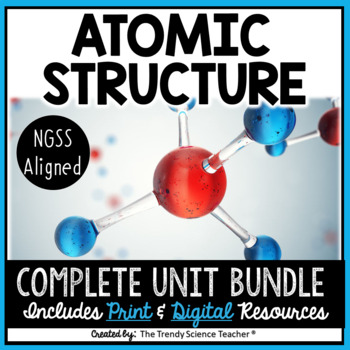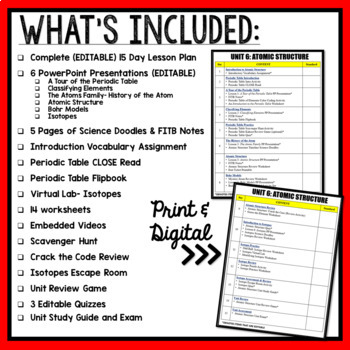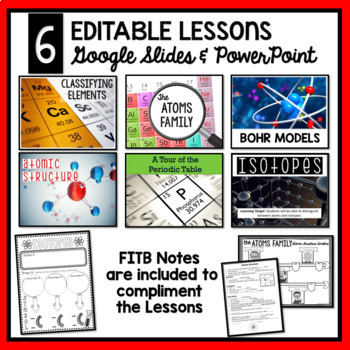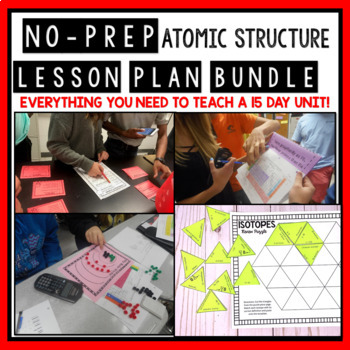Atomic Structure Unit
- Zip
- Google Apps™

What educators are saying
Also included in
- Save time and energy with this no-prep, PHYSICAL SCIENCE CURRICULUM bundle! This print and digital curriculum includes all of the lessons, notes, labs, activities, practice worksheets, STEM activities, projects, quizzes, review games and exams you need to teach an entire year of Physical Science. EvPrice $338.00Original Price $469.75Save $131.75
Description
Save time and valuable energy with this HUGE bundle of ATOMIC STRUCTURE resources. This bundle is the 6th unit in my PHYSICAL SCIENCE FULL YEAR CURRICULUM and is designed to be followed by my Matter Unit Bundle, but is the perfect supplement to any Physical Science curriculum.
This resource is just what you need to teach an engaging and student-focused NGSS Aligned Physical Science unit to your high school or middle school students. This no-prep resource is complete with everything that you'll need to teach a 15-day Atomic Structure unit. Because it's all-inclusive, this resource is especially useful to teachers that are new to teaching Physical Science.
Need a digital option? No problem! I have included both a printable version of this unit, as well as a digital (Google Drive) folder with digital versions of all of the resources. This unit bundle is perfect for distance learning, flipped classrooms, online courses, homeschool co-ops and traditional classrooms.
With over 13 years of experience teaching Physical Science, I have created (from scratch) a curriculum that has proven to be extremely engaging for my students. I am extremely proud of my high success rate on my state's end-of-course assessment and I want to share my resources with YOU. Why re-invent the wheel? The work has been done for you! Check out what's included in this valuable bundle:
Topics Covered:
►ATOMIC STRUCTURE
►THE HISTORY OF THE ATOM
►BOHR MODELS
►THE PERIODIC TABLE
►CLASSIFYING ELEMENTS
►ISOTOPES
What's Included:
►Editable 15-day Curriculum Guide (NGSS Aligned Standards)
►Daily Lesson Plans (editable)
►Editable PowerPoint Presentations for every concept (6 total)
►Over 20 Practice Worksheets w/ answer keys
►Periodic Table Flipbook
►Periodic Table Close Read
►Virtual Isotope Lab (no prep)
►Activities (no-prep & engaging)
►Doodle Notes (for some concepts) and FITB notes
►Crack the Case: Periodic Table Activity
►Editable Quizzes
►Exit Ticket Printables (10)
►Vocabulary Assignment
►Classroom Escape Activity (Isotopes)
►Introduction to the Periodic Table Activity
►Embedded video clips in PowerPoint lessons
►Unit review Game
►Unit Study Guide
►Editable Unit Exam
►A digital Google Drive filled with digital versions of the resources listed above
What types of files are included:
When you download this product you will receive a zip file with 15 folders of files that are divided by day. All of the PowerPoint & Google Slides Lessons are editable and you may customize them to fit your classroom needs. Most of the assessments are also editable. Many of the activities and documents in this product are secured PDF’s, meaning you can print them but not copy or edit the text. This is to protect the copyright and intellectual property of my own work, plus the work of many dedicated clip artists that are included in this product. You will also receive a link to a digital, Google Drive, folder filled with Google Forms, Google Slides and Google Docs of the resources. If you have questions about this, please don’t hesitate to email me with them!
Connect with me:
❤️Newsletter ❤️Blog ❤️Facebook ❤️Instagram ❤️Pinterest
TPT Customer Tips:
How to get TPT credit to use on future purchases: *Please go to your My Purchases page (you may need to login). Beside each purchase you'll see a Provide Feedback button. Simply click it and you will be taken to a page where you can give a quick rating and leave a short comment for the product. Each time you give feedback, TPT gives you feedback credits that you use to lower the cost of your future purchases. Feedback and ratings are most greatly appreciated. Be the first to know about my sales, discounts, freebies and new products: *Look for the green star next to my store logo (THE TRENDY SCIENCE TEACHER) and click it to become a follower. That's it! You will now receive email updates about this store.






